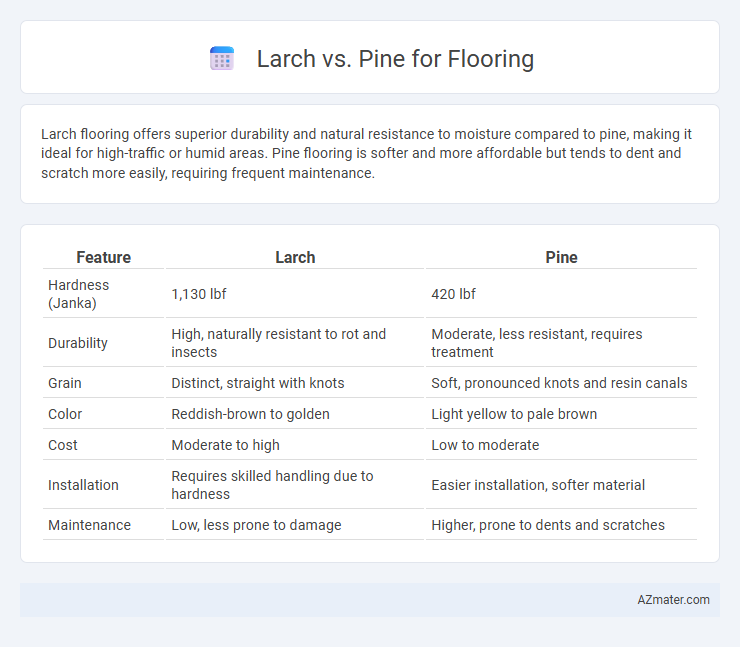Larch flooring offers superior durability and natural resistance to moisture compared to pine, making it ideal for high-traffic or humid areas. Pine flooring is softer and more affordable but tends to dent and scratch more easily, requiring frequent maintenance.
Table of Comparison
| Feature | Larch | Pine |
|---|---|---|
| Hardness (Janka) | 1,130 lbf | 420 lbf |
| Durability | High, naturally resistant to rot and insects | Moderate, less resistant, requires treatment |
| Grain | Distinct, straight with knots | Soft, pronounced knots and resin canals |
| Color | Reddish-brown to golden | Light yellow to pale brown |
| Cost | Moderate to high | Low to moderate |
| Installation | Requires skilled handling due to hardness | Easier installation, softer material |
| Maintenance | Low, less prone to damage | Higher, prone to dents and scratches |
Introduction to Larch and Pine Flooring
Larch flooring, known for its durability and distinctive reddish-brown hue, offers exceptional resistance to wear and moisture, making it ideal for high-traffic areas and damp environments. Pine flooring features a lighter, natural yellow tone with prominent grain patterns, valued for its affordability and warmth but requires more frequent maintenance due to its softness. Both wood types provide unique aesthetic and functional benefits, with larch favored for longevity and pine preferred for cost-effectiveness and classic appeal.
Wood Characteristics: Larch vs Pine
Larch wood is known for its exceptional hardness and natural resistance to decay, making it a durable choice for flooring in high-traffic areas. Pine flooring, by contrast, is softer and more prone to dents and scratches but offers a warm, rustic appearance with distinct knots and a lighter color palette. Both woods provide distinct grain patterns, with larch featuring a more pronounced, coarse texture, while pine presents a smoother surface that can be easily stained or finished to enhance its natural beauty.
Durability and Hardness Comparison
Larch flooring offers exceptional durability with a Janka hardness rating of approximately 1,200, making it resistant to dents and wear in high-traffic areas. Pine, with a lower Janka hardness around 600 to 900 depending on the species, tends to be softer and more prone to scratches and dents over time. Choosing larch flooring ensures longer-lasting resilience and strength compared to pine, which is better suited for areas with lighter foot traffic.
Appearance and Color Variations
Larch flooring offers a rich, warm appearance with distinct reddish-brown hues and striking grain patterns that enhance rustic and traditional interiors. Pine flooring displays a lighter, creamy color with unique knots and a softer texture, lending a casual and cozy feel to spaces. Both woods develop a natural patina over time, but larch tends to deepen in color, while pine may lighten or yellow with age.
Cost Differences Between Larch and Pine
Larch flooring typically costs more than pine due to its higher density and durability, which enhances longevity and resistance to wear. Pine is generally more affordable and widely available, making it a cost-effective option for budget-conscious projects. The price difference between larch and pine flooring usually ranges from 15% to 30%, depending on quality and sourcing.
Installation Considerations
Larch flooring offers excellent durability and natural resistance to moisture, making it suitable for areas with fluctuating humidity levels, but its dense grain may require pre-drilling during installation. Pine flooring is softer and easier to work with, allowing faster installation, yet it demands careful handling to prevent dents and scratches. Both woods benefit from acclimatization prior to installation to minimize expansion and contraction issues, ensuring a stable and long-lasting floor.
Maintenance and Care Requirements
Larch flooring offers excellent durability with moderate maintenance, requiring regular sweeping and occasional refinishing to maintain its natural resinous finish, which enhances resistance to moisture and pests. Pine flooring demands more frequent upkeep due to its softer wood structure, including periodic sealing and careful protection from dents and scratches to retain its aesthetic appeal. Both woods benefit from humidity control and prompt cleaning of spills to prevent warping and damage.
Environmental Impact and Sustainability
Larch wood flooring offers a sustainable choice due to its rapid growth rate and high carbon sequestration compared to many pine species, making it an eco-friendly option. Pine, while widely available, often comes from slower-growing varieties or plantations that rely on intensive management practices, increasing its environmental footprint. Choosing larch supports biodiversity and reduces deforestation pressures, enhancing long-term sustainability in hardwood flooring.
Best Uses and Room Recommendations
Larch flooring offers exceptional durability and natural resistance to moisture, making it ideal for high-traffic areas like hallways, kitchens, and mudrooms where resilience is crucial. Pine flooring provides a softer, warmer aesthetic that suits low-traffic rooms such as bedrooms, living rooms, and cozy reading nooks, offering a more comfortable underfoot feel. Both options can enhance rustic and cabin-style interiors, with Larch favored for its strength and Pine chosen for its classic charm and cost-effectiveness.
Final Verdict: Choosing Between Larch and Pine for Flooring
Larch flooring offers superior durability and natural resistance to moisture and decay, making it ideal for high-traffic and humid areas, whereas pine flooring provides a softer, warmer aesthetic with easier workability and affordability. The final verdict depends on usage and design priorities: choose larch for long-lasting strength and outdoor adaptability, or pine for budget-friendly, classic charm with simpler maintenance. Consider larch for premium durability and pine for a versatile, cost-effective flooring solution.

Infographic: Larch vs Pine for Flooring
 azmater.com
azmater.com